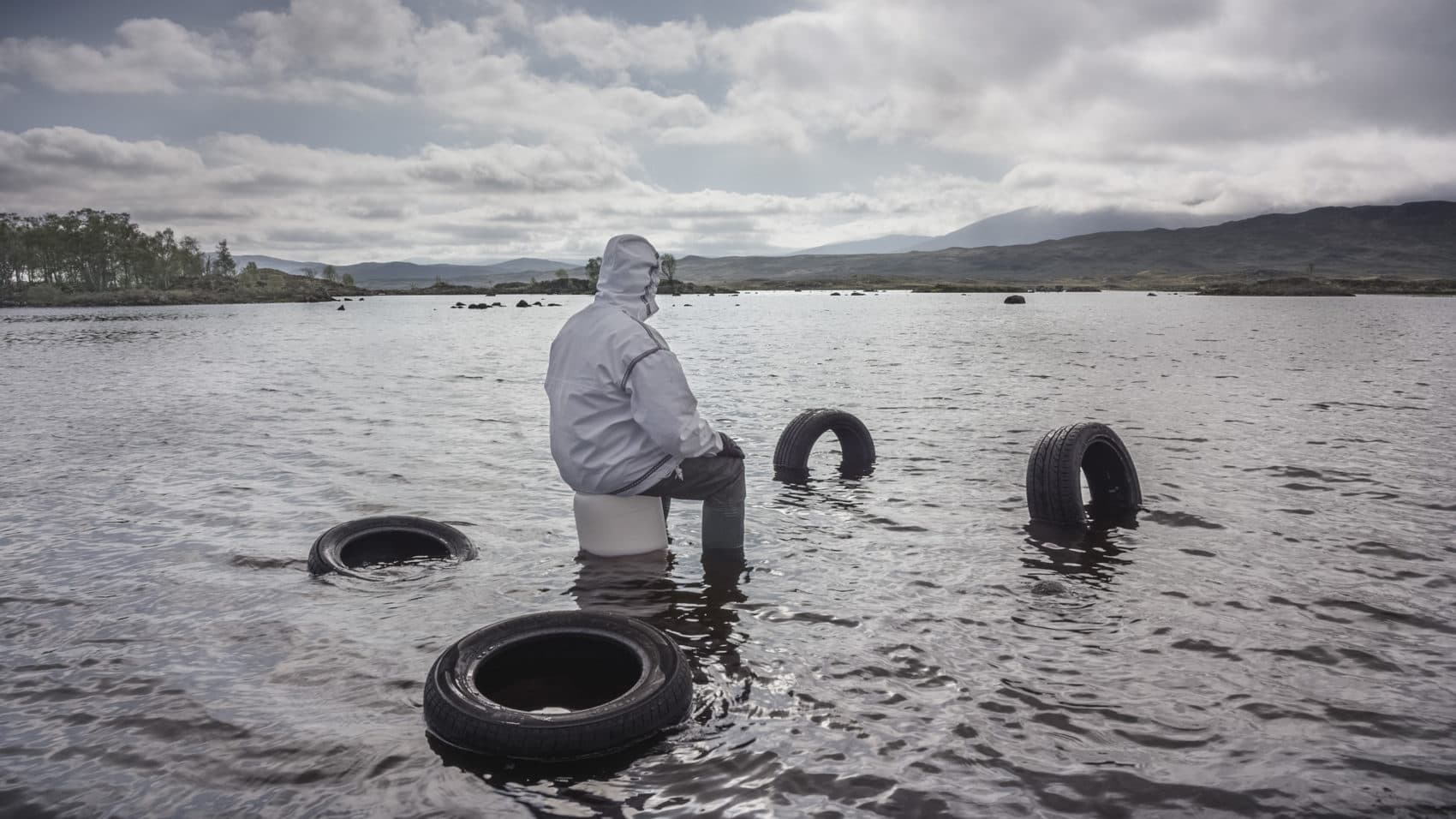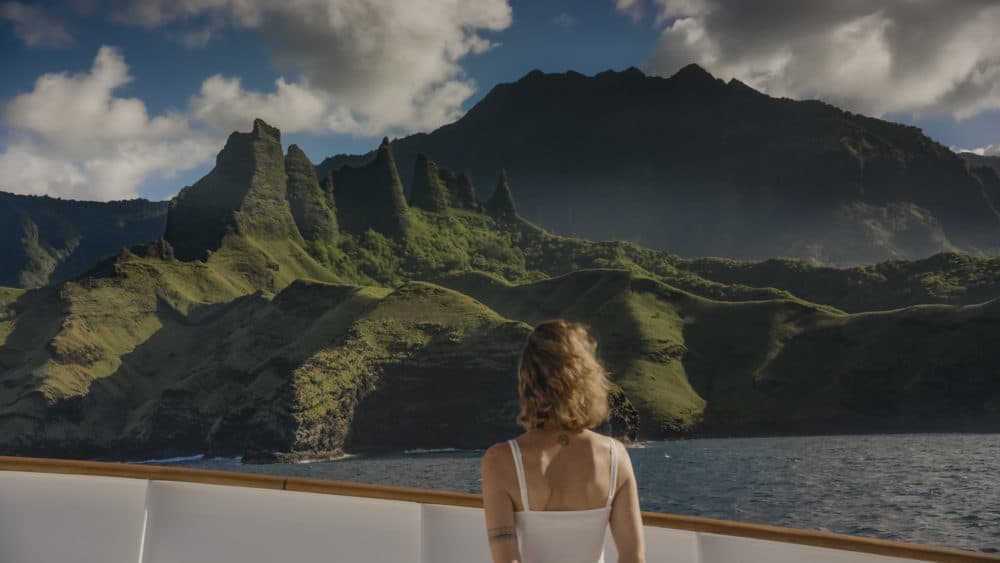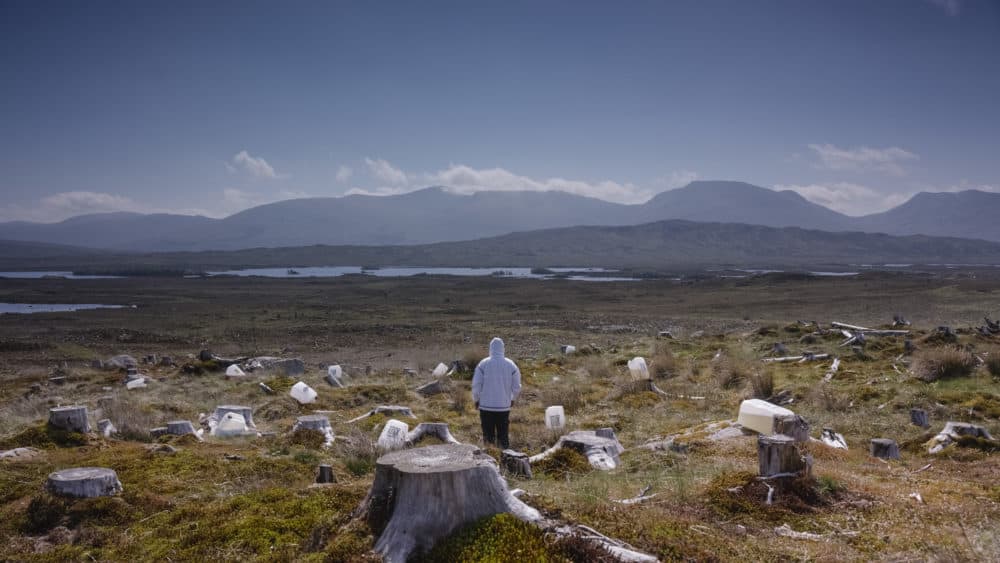Advertisement
At The ICA Watershed, John Akomfrah’s 'Purple' Mourns A Planet Lost

By now, climate change has become an irrefutable part of our lives. We can all see and feel it.
So, what are we to do about it?
British writer, filmmaker, artist and philosopher John Akomfrah offers no specific answers in “Purple,” his elegiac six-channel video installation opening Sunday at the ICA Watershed. Instead, he offers a somber reflection on all that has been lost.
And indeed, we’ve lost a lot. Greenland's ice sheet is melting faster with each passing year. Coastal communities in places like the Marquesas Islands are being engulfed by ocean waters. In Alaska, rising temperatures are threatening wildlife and indigenous communities.
We see glimpses of all that in Akomfrah’s hour-long full-immersion experience, but of course, many of us have already had our own full-immersion experiences with changing weather patterns. We can see for ourselves what’s happening around us — mega-fires, massive cyclones, wacky weather. The sheer ubiquity and obviousness of climate change could have wrested power away from this installation at water’s edge in the Boston Harbor Shipyard and Marina. What, a visitor might legitimately ask, does “Purple” offer beyond what we all already know?
“Just accepting the rather obvious fact that we're living it, is a step,” responds the artist. “I live and work on a planet where people still deny that this is going on. Just being able to accept that, seems to me to be a step forward. The thing is that artists have both an ethical and an aesthetic responsibility to try and suggest a way of looking at, living with, and overcoming this, in their work. We have to act responsibly, not to necessarily lecture to people or preach to them about what it is, but show how to navigate it, emotionally, intellectually.”
But before we learn to navigate the depth of what we have wrought, we must confront it.

And on that account, “Purple,” a montage of clips on six large adjacent floor-to-ceiling screens that traverse an entire theater creating a surround-sound experience, is powerfully adept. Here, no matter how much we might like to, we can neither deny nor look away. Scenes arise and dissolve before us, set to a rumbling soundtrack that combines natural sounds like the clap of thunder with solemn hymns sung wistfully by unseen vocalists. We see a mix of archival footage, including educational, industrial and nature documentaries from the 1950s and '60s, as well as clips from BBC arts programming. We also see newly-shot footage collected in 10 different locations around the world that are suffering the most devastating effects of climate change.
There’s no real narrative here. We see snapshots of human life and enterprise, from pregnancy to the birth of a child. We watch that child develop and become adult, indulging in actions that degrade the planet. While we dance and cavort, shop and consume, create new industries and technologies in the name of progress, we also poison our planet. Skies darken with smoke. Rivers and streams bubble with chemical froth. Industrial farming, manufacturing, our unbridled consumerism, our sheer greed, it all plays a role. Included in this vast montage are scenes referencing such ecological disasters as Chernobyl, Bhopal and Fukushima. Interspersed into the mix are bleak but carefully composed shots of a lone human figure set before an expansive landscape often under threatening skies that allude to a black future. The human figure set so sharply in contrast with an awe-inspiring landscape seems to suggest that man is indeed at the center of this catastrophe. Seeking dominion over nature, he has destroyed it. And yet, those same scenes suggest that nature is far grander and more powerful than man. We may take some consolation in that.
“I don’t think that what I do is a step beyond, let’s say an Al Gore film,” says Akomfrah, who created the film with collaborators Lina Gopaul and David Lawson of Smoking Dogs Films. “I think Al Gore’s films are absolutely critical. Ours is in the second league, if you will. It’s about saying, 'OK, I’ve seen that, now what do I do?' Mine is about trying to suggest what you do once you accept that this is fact.”

Back when Akomfrah was growing up in England, he lived a mile away from a coal-fired power station which he describes as “one of the biggest polluters in London.” At that time, he says, no one was drawing connections between the smoke spewing into the atmosphere and to climate change.
“Industrial progress and human life were seen as two separate things,” he says. “They weren't connected at all. In fact, they were very connected. Because we were being subjected to a daily dose of carbon monoxide poisoning. And just to be able to say that, for me, that is a game changer.”
His task as an artist, and with the film “Purple” is to “make seen the unseen.”
Permission for someone other than a scientist to consider climate change, is, according to Eva Respini, chief curator at the ICA Boston, what distinguishes Akomfrah’s work in an era in which ecological disaster is the daily fodder of news reports, scientific reports and policy papers.
“What's really so moving and so interesting about this work is this point of view of an artist,” she says. “This is not a point of view of a scientist or a journalist.”
She adds that artistic choices such as the soundtrack allow this film to take us places that Al Gore never did.
“It's a soundtrack that kind of comes at you almost in waves, like water,” says Respini. “You feel like you're being tugged in and it's washing over you in this amazing way when you actually experience this as an installation. It’s truly meant to be a physical experience.”

“Purple” is the second in a quartet of Akomfrah films in which the topic of climate change plays an important role. His first was "Vertigo Sea" (2015), which was shown at the 56th Venice Biennale. That film explored man's fraught relationship with the sea, including whaling and fishing practices and the sea’s role in slavery, migration and conflict. His third film in the quartet is “Four Nocturnes” (2019) and explores patterns of change in Africa. That film is currently being shown at the Venice Biennale. But with “Purple,” Akomfrah has allowed himself to ponder with more depth than the others the full import of climate change.
And as it should happen, the Watershed is perhaps the perfect venue for such a film. When you walk into the ICA annex, formerly a copper pipe and sheet metal factory, you are struck by the irony that a film on climate change should be shown in a setting that partially contributed to the problem. Outside the theater, you walk beneath a “chandelier” of old plastic jugs of the sort that used to hold water, oil, chemicals and various other solvents. The cloud of jugs was created by Akomfrah to accompany the exhibition.
“This issue of climate change, the issue of how human activity has affected our planet, really seemed just to be the natural fit for what we're hoping to do with the Watershed,” says Respini. The East Boston Shipyard’s role in history, its ties to immigration and industrialism made the Watershed the right place for the American premiere of “Purple.” And in fact, the ICA co-commissioned the film, along with Barbican in London and museums in Sweden, Lisbon and Moscow.
Viewers may wonder how Akomfrah settled on the name “Purple” to title his film. For Akomfrah, who was born in Ghana but who moved to England at the age of 4, the color is nuanced and involves opposites, which seemed fitting for the subject.
“Purple is a great color for discussing {opposites} because of course it’s a hybrid, it’s a mix of blue and red, it’s an inbetween, it’s not natural,” he has said.
Purple is also the color of mourning in Ghana. For this exhibit, in fact, the Watershed has been splashed in purple, including the walls and speakers and a purple carpet, to heighten the immersive effect.
In “Purple,” Akomfrah warns of the dangers threatening our dying planet. He draws compelling connections through time, and, beseeches us to take quick action against climate change, without sentimentality, but with conviction. The reality is, sadly, it may already be too late.
“Purple” is at the ICA Watershed from May 26 to Sept. 2. The museum is open from 10 a.m. to 5 p.m. Tuesday through Sunday, and open until 9 p.m. on Thursdays and Fridays. Admission to the Watershed is free and Water Shuttle transportation between the Watershed and the ICA is included in the ICA admission.
